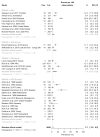Occupational Hantavirus Infections in Agricultural and Forestry Workers: A Systematic Review and Metanalysis
- PMID: 34834957
- PMCID: PMC8621010
- DOI: 10.3390/v13112150
Occupational Hantavirus Infections in Agricultural and Forestry Workers: A Systematic Review and Metanalysis
Abstract
Hantaviruses are zoonotic pathogens that can cause serious human disorders, including hemorrhagic fever with renal syndrome and hantavirus cardiopulmonary syndrome. As the main risk factor for human infections is the interaction with rodents, occupational groups such as farmers and forestry workers are reportedly at high risk, but no summary evidence has been collected to date. Therefore, we searched two different databases (PubMed and EMBASE), focusing on studies reporting the prevalence of hantaviruses in farmers and forestry workers. Data were extracted using a standardized assessment form, and results of such analyses were systematically reported, summarized and compared. We identified a total of 42 articles, including a total of 28 estimates on farmers, and 22 on forestry workers, with a total workforce of 15,043 cases (821 positive cases, 5.5%). A pooled seroprevalence of 3.7% (95% confidence interval [95% CI] 2.2-6.2) was identified in farmers, compared to 3.8% (95% CI 2.6-5.7) in forestry workers. Compared to the reference population, an increased occurrence was reported for both occupational groups (odds ratio [OR] 1.875, 95% CI 1.438-2.445 and OR 2.892, 95% CI 2.079-4.023 for farmers and forestry workers, respectively). In summary, our analyses stress the actual occurrence of hantaviruses in selected occupational groups. Improved understanding of appropriate preventive measures, as well as further studies on hantavirus infection rates in reservoir host species (rodents, shrews, and bats) and virus transmission to humans, is needed to prevent future outbreaks.
Keywords: climate change; hantaviruses; public health; sectors of activity; work-related disease; workers; zoonoses.
Conflict of interest statement
The authors declare no conflict of interest.
Figures







References
Publication types
MeSH terms
LinkOut - more resources
Full Text Sources
Medical
Research Materials

